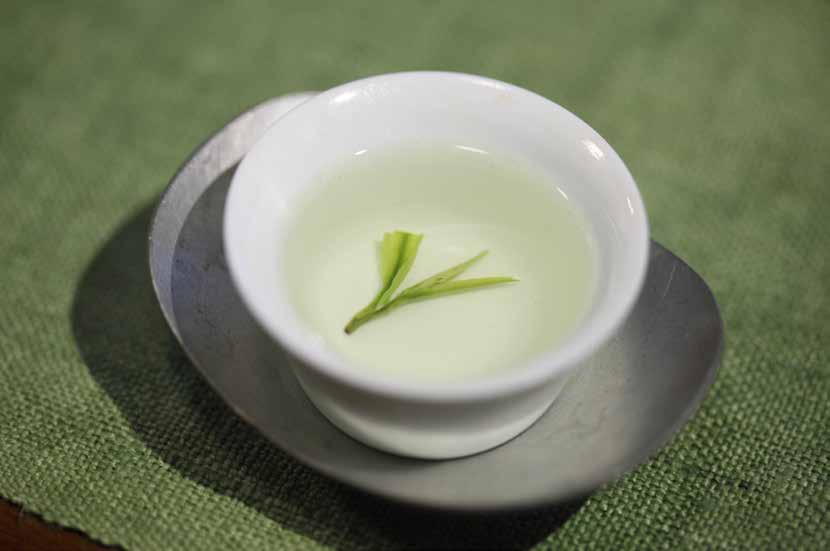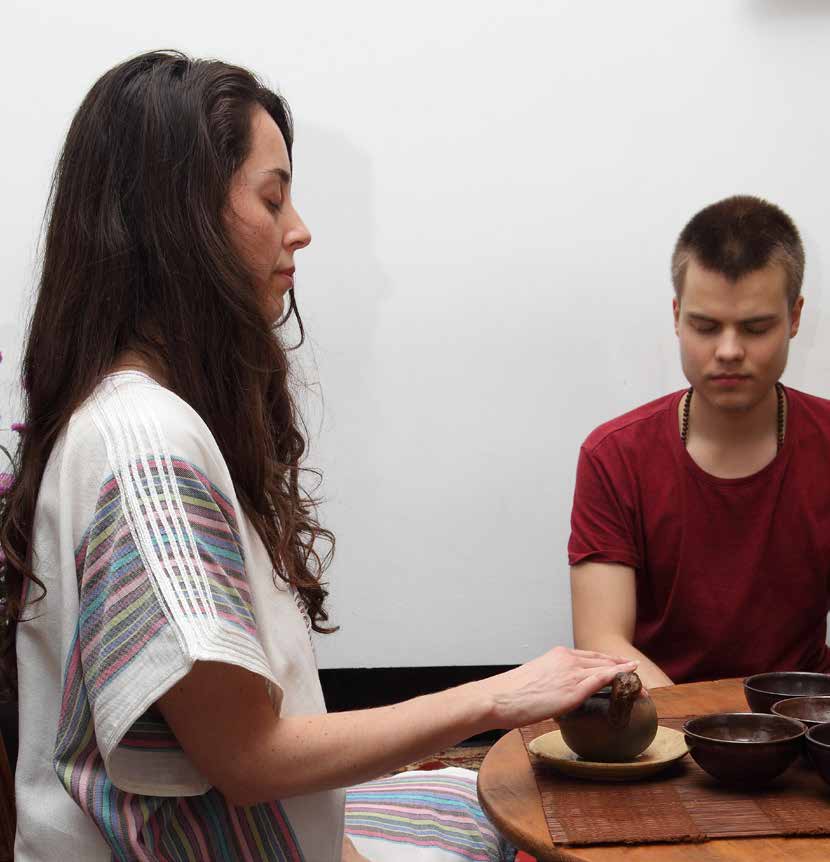
 |
|

One of the greatest shifts in the tea journey is a step beyond aroma and flavor to all the subtler dimensions tea offers. As soon as these other worlds are unlocked, your ability to evaluate tea, teaware and brewing methodology all develops much more quickly. In the Classics of Tea, Lu Yu says that you never discern the quality of tea by "merely contemplating its flavor or sniffing its aroma", suggesting that he, too, understood this shift in perspective. Of course, the mastery of tea is a lifetime endeavor, and there is always more to learn. But with a bit of guidance and focus, you can begin accumulating your own experience and learn how to make better and more refined tea. Since fine teas are so difficult to produce, requiring the perfect balance of mountain, water and sun as well as days of sleepless toil, we honor them by improving our ability to extract greater and more rewarding cups from our brews: learning to prepare and appreciate tea more fully is actually the culmination of this process - from seed to sprout, calloused hand to elegant pot...
Most of us are first enticed into the tea world through the amazing and exotic flavors and aromas a cup of tea offers. There is a great pleasure in fine tea, sometimes deep enough to cause a sigh. And it is difficult for some to see beyond the flavor and aroma, as they are often overwhelming. There is never a time in which they need to be quit, or enjoyment set aside, but our development in tea and ability to communicate quality will always begin at a slightly deeper level. In other words, continue to relish the wonderful flavors and aromas your tea offers while at the same time expanding and deepening your appreciation to other, subtler levels. After all, the movement towards mastery of any art is always towards sensitivity to subtler, more refined aspects. This doesn't mean you lose the awareness of its more obvious, gross qualities, though.
If you've ever read a review of teas, you see that often the various participants have such discordant views that the results are almost unrewarding. Obviously, the differences in preparation methods, teaware and water reduce most tea reviews to a matter of opinion. It would perhaps be better for such authors to focus on sharing more information and insight into their criteria for choosing tea, water and preparation methodology, rather than their opinions on certain teas.

Still, even with the same water and teaware, opinions will vary just as greatly when the focus is on flavor and/or aroma. This is because everyone has their own taste: some like chocolate and some like strawberry. And arguing over which is better is rather pointless, don't you agree? The fact is, there is no higher-quality flavor or aroma, merely one that is more suitable to you than the other. Everyone tastes and smells tea differently. This is in part due to our different taste buds, as well as how sensitive our noses are (how calm and focused you are while tasting plays a part as well, incidentally).
Even if our palates were more similar than different, evaluating and then communicating our preferences in flavor and aroma would still be very difficult because so much of our discrimination is based on our past experience. How much tea you have drunk in your life - both in kind and in amount - will drastically influence your perception of a given tea. You will then compare the flavors and aromas to other things you have tasted before, saying this tea tastes like "mushrooms" or "toasted bamboo." It actually doesn't taste like anything other than itself - the association is in your mind and based on the interaction of the tea with your mind. We can influence others, by asking them to focus on a tea's "cinnamon" quality, but they will only recognize it if they have had enough cinnamon prior to trying the tea. Because we all have our own taste and opinion, there can't really be much agreement or development based on flavor or aroma. Even the teas you find absolutely disgusting are enjoyed by somebody; and sometimes others scoff at the teas you love. You might even find that a tea with flavors and aromas you absolutely adore taste flat one day, and wonder what happened to its incredible aroma. Perhaps it had to do with what you ate that day, the weather, changes in preparation or any number of other immeasurable variables. There are a lot of us here in Asia who love a bit of mustiness in our aged Puerh. Maybe this is an acquired taste. There is no point in arguing to us that this means our Puerh is lower quality, when it brings us such joy. Obviously, it would be equally absurd for us to force you to drink lots of musty Puerh if you don't like the flavor, just like it is silly to argue that the stinky fruit durian should be enjoyed by everyone, everywhere. Some people love durian and some hate it. It neither tastes good nor bad. It tastes good or bad to certain people.
What then should we focus on when evaluating and discussing tea? If not flavor and aroma, then what? Actually, there is a whole world of subtleties within a cup of tea beyond the flavor and aroma, and many of them are much more "objective", in that most of us can agree on what we want. The first movement, after aroma and flavor, is towards what we call "mouthfeel (口感)".

The masters use the analogy of clothes when teaching about the differences between mouthfeel and flavor. Everyone likes different styles and colors of clothes. There is nothing wrong with that, and people should wear the style they like. And yet, when we close our eyes, we can all agree on which material is comfortable just by touching it. We all want smooth, soft material that can breathe on our bodies. Granted, some people sacrifice this comfort for clothes that look a certain way - have a certain style - but as soon as they get home, the first thing they do to "get comfortable" is change back into smooth, soft clothes which are made of natural fibers and can breathe. While we all have different tastes in colors and styles, we all can feel which is the most comfortable. And ultimately, tea is the same: we all enjoy different kinds of tea more or less, and appreciate different flavors more or less, but at the same time when it comes to the texture - the mouthfeel - of a tea, we all want it to be smooth.
Start paying attention to the way the tea touches your mouth and throat. Is it smooth or rough? We have found that the best teas are very smooth and comfortable. As soon as they enter the mouth, they splash up to the upper palate. The swallowing should occur naturally. With the finest teas, it's as if the tea goes down on its own, without any conscious energy in the swallowing. The best teas have a tendency to slide back on their own. They "want" to go down, in other words. Lower-quality teas, on the other hand, have a tendency to pool in the front of the mouth, and you have to consciously push them to the back of the mouth and then consciously swallow them as well.
The best teas coat the mouth like milk or oil, so that after you swallow, you can feel the tea everywhere in your mouth, and slowly rising up into your nasal cavity. The tea should also be comfortable in the throat, often lingering on the breath for some time. This splashing up to the upper palate, traveling down smoothly, leaving the mouth moist and coated, as well as lingering on the breath are all signs of a fine tea. The more of these characteristics a tea has, the more comfortable it will be in your mouth.
Focusing on mouthfeel doesn't mean forever losing an appreciation of aroma or flavor, keep in mind. The best tea brewers can enhance any given tea in the most amazing way. What was flat and boring is full of life when prepared with skill. It never will cease to leave you awestruck: the way the tea is just better - in every way - when prepared by master hands. The master brews tea that is delicious and fragrant, but draws you in to subtler and subtler levels like mouthfeel.
When you begin to focus on mouthfeel, you'll find a whole world of textures and sensations awaiting you. It often helps to try this with water, or weaker tea if you are having trouble being overwhelmed by flavor and aroma. After time, however, you will find that you are capable of appreciating and evaluating a tea's flavor and aroma while simultaneously recognizing if the mouthfeel is smooth or not. And you'll find that when discussing mouthfeel with others, there is always a greater concordance than our different tastes can ever offer. Pointing out the way a tea feels in the mouth one time is usually enough, even for a beginner. They are often able to begin feeling the effect quickly.
Furthermore, the evaluation of mouthfeel isn't just limited to tea. It also helps you choose which water and teaware is more suitable for preparing any given tea, as you begin to notice how certain water or teaware makes a tea smoother or rougher, and is therefore more or less desirable. The more sensitive we become to this, the more we are able to make teas which reward us with great flavors and aromas, as well as comfortable mouthfeel.
As you move towards subtler and subtler aspects of tea, you find that after mouthfeel there are other levels as well, including the Qi of the tea. There is of course more to mouthfeel than what we have introduced here, but just the shift in focus away from flavor and aroma, to include these subtler levels will be a huge leap in your ability to appreciate tea, and ultimately prepare better cups for others, which is what gong fu tea is really all about.

